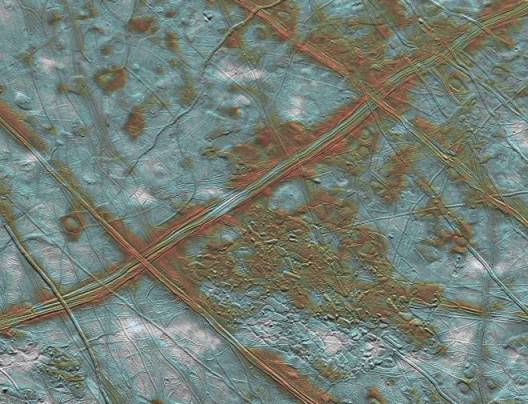Explanation: The large Jovian moon Europa may harbor liquid water beneath its frozen crust. Controversy surrounding this idea has been recently fueled by dramatic images of Europa's surface from the Galileo spacecraft. This alluring color image was produced by combining low resolution color data with higher resolution mosaics recorded during three separate flybys and covers about 120 by 150 miles. The eerie terrain of grooved linear ridges and crustal plates which seem to have broken apart and rafted into new positions could indicate subsurface water or slush. Blue tints represent relatively old ice surfaces while reddish regions may contain material from more recent internal geological activity. White splotches are bright material blasted from the young impact crater Pwyll located about 600 miles south (to the right) of this area. Many believe that large reservoirs of water hold out the tantalizing possibility of organisms living on this dim, distant world.
1999 2000 2001 2002 2003 2004 2005 2006 2007 2008 2009 2010 2011 2012 2013 2014 2015 2016 2017 2018 2019 2020 2021 2022 2023 2024 2025 |
Yanvar' Fevral' Mart Aprel' Mai Iyun' Iyul' Avgust Sentyabr' Oktyabr' Noyabr' Dekabr' |
NASA Web Site Statements, Warnings, and Disclaimers
NASA Official: Jay Norris. Specific rights apply.
A service of: LHEA at NASA / GSFC
& Michigan Tech. U.
|
Publikacii s klyuchevymi slovami:
Jupiter - Europa - Evropa - led
Publikacii so slovami: Jupiter - Europa - Evropa - led | |
Sm. takzhe:
Vse publikacii na tu zhe temu >> | |
